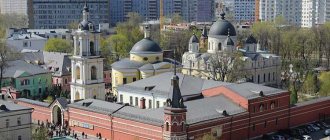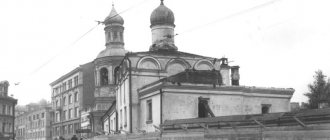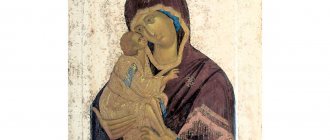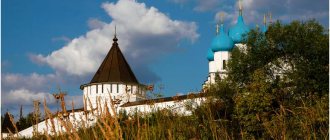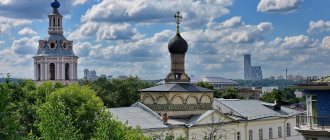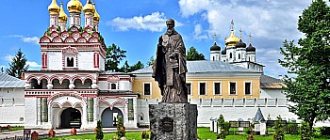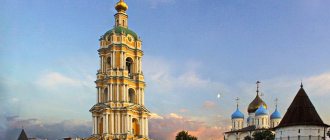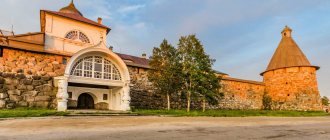Donskoy Monastery is a male stauropegial monastery in Moscow. The monastery was built in 1591 in the place where Russian troops repelled the attack of the Crimean Khan of Gaza II Giray.
The monastery is famous for the fact that the oldest noble necropolis in Russia has been preserved on its territory; famous poets, writers, architects and scientists are buried in the monastery cemetery.
Photo of the Donskoy stauropegial monastery located in Moscow
Donskoy Monastery was founded in honor of the defenders of Moscow
The history of the monastery dates back to the 16th century. The Don Monastery was built on the initiative of Tsar Fyodor Ioannovich in 1591. The foundation of the monastery is to commemorate the victory of Russian weapons over the army of the Crimean Khan Gaza-Girey.
The Donskoy Monastery was erected in the place where Boris Godunov’s detachment and the camp church of Sergius of Radonezh stood. The construction of the monastery was the final stage in the creation of a defensive line on the outskirts of Moscow from the southern steppes.
The Donskoy Monastery closed the defensive chain of Moscow against raids from the southern steppes.
The monastery received its name in honor of the Don Icon of the Mother of God. According to legend, it was in this image that Sergius of Radonezh blessed Dmitry Donskoy and his soldiers before the battle on the Kulikovo Field.
The first building on the territory of the modern monastery was the Cathedral of the Don Icon of the Mother of God (also called the Small or Old Cathedral) - a single-domed temple that ended with three-stage rows of kokoshniks hiding the vaults.
During the construction of the Church of the Intercession in Rubtsov, the Kazan Cathedral on Red Square and other churches, this cathedral was used as a model.
Cemetery of the Donskoy Monastery graves of famous people photo
More than 100 eminent personalities are buried on the territory of the Don cemetery. Russian nobles, prominent dignitaries, representatives of the merchant class were buried here, for example, here is the family tomb of the Vyazemskys, Trubetskoys, Dolgorukys, Golitsyns.
Also here you can find the tomb of Chaadaev, Odoevsky, Klyuchevsky, Solzhenitsyn, Maykov and others. Quite a few Russian monumentalists, seventeenth-century generals, representatives of the Empire movement, French sculptors and architects are buried.
In troubled times, the Small Cathedral was destroyed
During the Time of Troubles, the Old Cathedral was looted and destroyed. During the restoration under Mikhail Fedorovich, the monastery was restored, but unfortunately not completely.
In 1650, the Donskoy Monastery was assigned to St. Andrew's, and in 1673 a refectory part was added to the Small Cathedral.
In 1678, in honor of the victory over the Turks in the Battle of Chiginir, two chapels were erected - the southern one in honor of Sergius of Radonezh, and the northern one in memory of the Great Martyr Fyodor Stratelates.
In 1679, the Donskoy Church was painted by Leonty Chulkov and Fyodor Evtiev.
Ivan Zabelin
Russian historian, specialist in the history of Moscow
Historian Ivan Zabelin described the Time of Troubles as follows:
“Soon after the death of Tsar Fyodor Ioannovich, the Time of Troubles in our history began, a time of imposture and interregnum, disastrous for the entire state and, especially, for Moscow. Then almost the entire throne room was burned and devastated by the Poles, so contemporaries very rightly called this time the Moscow devastation. The newly founded monastery, which suffered the general fate of destruction and devastation, did not escape the evil disaster. Since it was actually a sovereign building, in this stateless time there was no one to remember it; he was forgotten and left in the care of his meager brethren.”
In 1687, the monastery restored its abbess and its original independence, and before that, in 1679, the Sharovkin Assumption and Zhizdrinsky Trinity monasteries, as well as Tikhon’s Monastery, were assigned to it.
1684
this year the construction of the Great Cathedral of the Donskoy Monastery began
In 1684, construction began on the Great Cathedral of the Donskoy Monastery, but already in 1687 the work was frozen due to the Crimean campaign of Peter I and the depletion of the monastery treasury.
The construction of the new temple was completed only in 1697. The large cathedral was built in the Naryshkin style and placed on a high basement. Its heads were installed in the direction of the cardinal points.
During World War II, the monastery was plundered by French soldiers
The modern complex of the monastery was formed throughout the 18th century. Thus, from 1686 to 1711, builders erected a stone fence with twelve towers at the expense of the son of the Duma clerk Yakov Kirillov, who owned chambers on Bersenevskaya embankment.
In 1714, the Don Church was erected above the northern gate of the monastery in honor of the Tikhvin Icon of the Mother of God.
Between 1730 and 1753, a bell tower was erected over the western gate. The construction was carried out in turn by three architects - Pietro Trezzini, Dmitry Ukhtomsky and Alexey Evlashev.
Archbishop Ambrose Zertis-Kamensky, killed within the walls of the Donskoy Monastery during the Plague Riot
In 1771, during the Plague Riot, Archbishop Ambrose was killed in the monastery. During the epidemic, the clergyman ordered the Bogolyubskaya Icon of the Mother of God to be removed from the Varvarsky Gate of Kitay-Gorod.
This step enraged the people, in the heat of which they killed the archbishop, who was hiding in the monastery.
In the first half of the 80s of the 18th century, the Italian artist Anton Claudo painted the walls of the Greater Cathedral with gospel and biblical scenes.
The appearance of the temple also underwent changes - the main volume of the quadrangle was built on, the rows of kokoshniks were hidden, and the roof received a hipped roof.
Kokoshnik
in architecture: semicircular or pointed completion of a facade or vault
During the Patriotic War of 1812, the monastery was barbarically plundered when Napoleonic army occupied Moscow. Part of the regiment of the Second Horse Guards was quartered in the monastery; the horses lived in cells along with the privates.
Leaving the monastery, French soldiers stole crowns from icons, frames, vestments and all other decorations.
The premises of the Donskoy Monastery were partially destroyed. The monastery was restored with donations from the ataman of the Don Cossack army, Count Matvey Platov. With his money, new icons of the iconostasis of the Great Cathedral were made.
Holy Donskoy Starocherkassky Monastery Diocesan monasteries of the Russian Orthodox Church
In 1644, after the end of the “Azov siege,” the Cossacks founded their capital in Starocherkassk. During its heyday, Cherkasy was famous for its rich market and lively trade. Temples were also built here. Among the glorious Cossack families in Starocherkassk, the family of Ataman Efremov was famous for its piety and heroism. It was Ataman Daniil Efremov who founded a temple in Cherkassk in the name of the Don Icon of the Mother of God (as his home church). In December 1831, the descendants of the famous Cossack family of the Efremovs turned to the ruling bishop with a request to form a women’s monastery at the church in the name of the Don Icon of the Mother of God, donating almost all their funds and lands to the Don diocese. “Having the full right of inheritance, we, for the glory of God and in memory of the relatives of our family, whose ashes rest in this church, donate the house with this temple and all the services in the house forever for conversion to a nunnery.” In 1836, a Decree of His Imperial Majesty was signed on the establishment of the Efremov Convent in the village of Starocherkasskaya, conferring upon it the degree of III class. A host of clergy arrived at the opening ceremony of the monastery not only from Cherkassk, but also from neighboring villages. Thus, the former Efremovskaya house church of the Don Icon of the Mother of God became a monastery church. The first nuns of the monastery were nuns from the only nearby Ust-Medveditsky convent. The internal life of the newly formed Ephraim monastery began to be organized according to his example. Strict requirements were imposed on those entering the monastery, and even stricter demands were placed on the nuns: nuns had to be distinguished by all Christian virtues, especially humility, patience, kindness and complete obedience to their superiors. Far beyond the boundaries of the village, the handicrafts of nuns and novices, especially gold seamstresses, were known. Mainly, items of church utensils, embroidery, beaded and pearl frames were produced. Residents of the Don villages and cities willingly purchased monastic products.
Year by year, the monastic economy expanded, subsequently providing everything necessary not only for the nuns of the monastery, but also for many lay people in need of help. A sacristy building, a hospital building, a refectory, and a hotel were erected. Lands that were used for agricultural needs were added to the previous holdings. The spiritual authority of the monastery was very high in the Don region; the great charitable activities of the monastery were known in the capital St. Petersburg. The Starocherkassky Monastery is one of the first convents in Russia to actively participate in primary education. The monastery school for girls was very popular. Not only Cossacks from different villages sought to send their daughters here, but also the clergy and people from other cities, including the townspeople and merchants of Rostov, Taganrog and Yeisk. Traditionally, Russian society believed that it was monastic education and training that the future mother and housewife needed. Therefore, the number of applicants exceeded the capabilities of the monastery. The Ephraim Convent reached a special flourishing in its spiritual structure, economic development and decoration at the end of the 19th and beginning of the 20th centuries under the leadership of Abbess Innocent. She had great authority in the Don Army Region and beyond; consisted of personal correspondence with Metropolitan Michael of Serbia and the Serbian reigning house. Conversations with Abbess Innokentia aroused among high-ranking officials the desire to create a convent in Serbia “modeled on Starocherkassky.” During the years of Soviet power, the monastery suffered the common share of Orthodox monasteries.
In June 1924, the volost executive committee decided to place an orphanage in the Ataman Palace. The monastery was closed, the nuns and novices were evicted. Thus began the new life of the farmstead. It brought destruction to most buildings. The pearl of the monastery - the Church of the Don Mother of God - lost all its valuables, and then all its interior decoration. The upper part of the church and bell tower were blown up. Most of the nuns left, but several of them remained to live in the village of Starocherkasskaya with friends and relatives, carrying out their feat of prayer.
Until 1970, the buildings of the monastery cells housed a boarding school for mentally retarded children and a rural hospital. After the Great Patriotic War, part of the buildings was occupied as a boarding school for the disabled. In 1970, the State Starocherkassk Historical and Architectural Museum-Reserve was founded, which included a complex of monuments on the monastery courtyard of the 18th-19th centuries, which received federal status.
Almost seven decades after the closure of the Efremov convent in the village of Starocherkasskaya, through the Providence of God, monastic life is being revived again. In March 1994, the Holy Don Starocherkassky Monastery was registered with the Main Department of Justice of the Rostov Region. The Starocherkassk Historical and Architectural Museum-Reserve transferred to him three destroyed objects of the former monastery property: the Church of the Don Icon of the Mother of God, the preserved foundation of the former sacristy and the completely destroyed hospital building, where the almshouse and refectory were previously located. The remaining buildings of the former Efremov Monastery still house exhibitions of the museum-reserve, telling about the history of the Don Cossacks and the village of Starocherkasskaya.
Over the past years, the church in the name of the Don Icon of the Mother of God fell into a state of terrible desolation: there were no doors, windows, plaster, iconostasis, wall paintings, or icons; in the altar of the temple, “tourists”, visitors to the museum, set up a latrine. Two side chapels were destroyed: in the name of St. Nicholas the Wonderworker and St. Daniel the Stylite, and the size of the refectory part of the temple was reduced by almost half. The brethren of the Holy Don Monastery first of all set to work on restoring the temple, clearing and improving the surrounding area. The graves of the deceased from the Ephraim family and Abbess Innocentia near the temple were put in order. A six-tiered iconostasis was installed in the Donskoy Church, the icons for which were painted in the Old Russian style; Bells appeared on the bell tower.
Initially, in 1994, the brethren of the Holy Don Monastery consisted of ten inhabitants. They all settled in the village of Starocherkasskaya in a small private house, rented. Then we had to spend the winter for one year, sleeping in sleeping bags, in the Zhuchenkovs’ house (one of the museum objects rented). But, despite any difficulties, the monastic prayer did not weaken. While the restoration of the Church of the Don Icon of the Mother of God was underway, services were held in the unheated Military Resurrection Cathedral, and since 1997, daily services began in the monastery church. The daily celebration of the Divine Liturgy and the full circle of worship immediately had a beneficial effect on the external and internal life of the Starocherkassk monastery. The brethren of the monastery strengthened in spirit and improved in virtues thanks to the wise spiritual guidance of the gracious elder Archimandrite Modest. In the monastery, tonsure into the cassock and mantle, ordination to the deacon and priestly ranks took place. The Church of the Don Mother of God and other destroyed buildings transferred to the monastery were restored and decorated.
Currently, the brethren of the monastery consists of 25 people: 12 hieromonks, 2 hierodeacons, 4 monks, 2 monks, 5 novices.
Life in monasteries has always been based on prayer and work - these cornerstones of centuries-old Orthodox monasticism. The day begins with the morning rule in the temple: morning prayers, midnight office, Akathist to the Mother of God. Then the brethren disperse to their obediences: they celebrate the Divine Liturgy in the church, others go to work in the bakery, to the garden, to the apiary, to the construction site. Divine services are performed daily in the monastery church by the brethren of the monastery. A fraternal choir sings on the choir: on weekdays in the traditional Russian Znamenny chant, on Sundays and holidays - in three or four voices according to the chant of the Holy Trinity Lavra. The statutory monastery services are liked by pilgrims, and many, having once attended a service in the monastery, strive to return here again and again.
In the monastery, all work is distributed among the brethren, everyone knows their obedience. Over time, the monastery acquired its own farm: an apiary, a vegetable garden, and a livestock farm. More recently, fisheries have appeared, the presence of which has always been mandatory for Russian monastic possessions. On the refectory table there is always home-baked bread, vegetables and fruits, honey and jam. There is a lot to do in the monastery, enough for both the brethren and the numerous pilgrims who want to contribute to the restoration of the monastery.
The Holy Donskoy Starocherkassk Monastery, preserving traditional Orthodoxy, continues the monastic feat on the Don land. From the very beginning of the revival of the Holy Don Monastery, the Lord sent shrines to strengthen our faith, to which to this day many people flock to the monastery, seeking the salvation of their souls.
In 1995, the Cossacks of the village of Gnilovskaya presented the monastery with a large Don Icon of the Mother of God. For some time she was in the Military Resurrection Cathedral while the monastery church was being restored. Subsequently, this icon was solemnly transferred to the monastery church dedicated to it. The Don Icon of the Mother of God is the main shrine of the Starocherkassk monastery. With her, on the twelfth holidays, religious processions take place around the monastery.
In 1998, one of the prayer books for the reviving monastery, Schema-Archimandrite Zosima of the Holy Dormition Monastery of the Donetsk Diocese (Sokur, +29.08.02), presented the monastery with a small reliquary with 34 pieces of relics of saints. It contains particles of the relics of the Holy Apostle Andrew the First-Called, Equal-to-the-Apostles Mary Magdalene, Martyr Tatiana, Great Martyr Panteleimon and many others. Shortly before his death in 2002, Schema-Archimandrite Zosima blessed the monastery with another great shrine: a large relic containing more than 90 pieces of the relics of the venerable fathers of the Kiev Pechersk Lavra. The reliquary contains a particle of the Calvary Stone. The monastery stores icons with pieces of the relics of the patron saint of the Don land, St. Demetrius of Rostov, St. blgv. Prince Alexander Nevsky, martyr. Tryphon, Saint Nicholas the Wonderworker.
Relatively recently, an icon of St., revered in Russia, appeared in the Starocherkassky Monastery. Luke of Crimea with pieces of relics, and in 2014, an icon of St. Lyudmila, Princess of Bohemia, with a piece of her honest relics was brought to the Holy Donskoy Starocherkassky Monastery. The painting and design of the image of Saint Lyudmila, Princess of Bohemia, became possible thanks to the joint efforts and efforts of the brethren of the monastery and the feasible donations of Orthodox believers. The icon was painted by master icon painter from Rostov-on-Don A.D. Lysak. To confirm the authenticity of the particle of the relics of the holy saint, which are in the icon, on its reverse side, using modern laser technologies, a letter from Archbishop George (Orthodox Church of the Czech Lands and Slovakia) was applied, confirming the transfer of a particle of the honest relics and their origin from Prague.
In 2015, on the feast of the Holy Trinity, another 18th-century icon of St. Nicholas of the Lycian Wonderworker, restored by the labors of the brethren of the monastery, was solemnly brought to the Holy Don Monastery. The frame of the 18th century was restored by chasing in copper with silver plating. To accompany this icon, a benefactor of the monastery presented a reliquary in the shape of a bishop's panagia, made by a Don jewelry maker. A piece of the relics was brought from Venice thanks to the efforts of patrons of the Don Metropolitanate and mounted in the panagia.
In the summer of 2014, an ark containing a particle of the relics of St. was brought to the monastery. Prophet John the Forerunner and Baptist of the Lord. They were brought by the efforts of the brethren of the monastery and the Bugrov family and mounted in a silver reliquary.
Some of the last icons that appeared in the monastery church of the Don Icon of the Mother of God can be called icons with particles of the relics of the Yaroslavl saints, Sophrony of Iveron, Hilarion of the Trinity, Patriarch Tikhon, Mary of Gatchina.
A place of constant pilgrimage and consolation for believers is the resting place of Archimandrite Modest (Potapova, +14.03.02), buried behind the altar of the Donskoy Church. Archimandrite Modest was the first abbot of the Holy Don Starocherkassky Monastery. Many people from different parts of Russia turned to him for spiritual advice and guidance. Father Modest kept his faith in God from childhood, carried it through the difficult years of fighting against God, had extensive experience in worship, and his life experience was enriched by communication with the elders of the Glinsk Hermitage, one of whom he was in the care of. Archimandrite Modest became a living thread connecting the monastic brethren, consisting mainly of young people 25-35 years old, with the ancient ascetics of Holy Rus'.
Today many people come to the Starocherkassky Monastery. Some want to receive spiritual support and strengthen their faith, others want to attend divine services, learn prayer, and others want to work hard and provide all possible assistance to the monastery economy for the glory of God. The brethren of the monastery pray with gratitude for benefactors, pilgrims and everyone involved in the revival of the Holy Don Starocherkassky Monastery.
Approaching Starocherkassk, you can admire the new patinated copper domes that now decorate the Military Cathedral. With the help of benefactors, the heating system of the Military Resurrection Cathedral was restored, which had a beneficial effect on the preservation of ancient icons. After many decades, it became possible to hold services in the Military Cathedral in the winter (previously, services were held only in the warm season, starting with Easter). Continuous restoration work is underway. The facade of the Transfiguration (Ratnensky) Church has been restored, and work is underway on the interior decoration. In recent years, several monastery buildings have been built and restored
Donskoy Monastery became the last refuge of Patriarch Tikhon
In 1914, on the territory of the New Donskoy Cemetery of the monastery, a temple was consecrated in the name of the Venerable Seraphim of Sarov and Anna Kashinskaya. After the October Revolution, a crematorium was located in the temple building.
The Donskoy Monastery, like many churches and monasteries, was closed in 1918. Since 1922, Patriarch of Moscow and All Rus' Tikhon was kept under arrest within the walls of the monastery. He died in the monastery in 1925, a year after an unsuccessful attempt on his life.
Patriarch of Moscow and All Rus' Tikhon, held under arrest in the Donskoy Monastery
In 1926, the monastery was transferred to the management of the Museum Department of the Main Science. But already in 1929 the museum was closed, the community was liquidated, and the Anti-Religious Museum of Art began to operate in the monastery.
Fortunately, the monastery archives of the 18th – 19th centuries survived - they were transferred to the Russian State Archive of Ancient Acts and the Central Historical Archive of Moscow.
In 1934, the monastery was transferred to the jurisdiction of the Museum of Architecture of the USSR Academy of Architecture.
After this, parts, shrines and sculptural fragments of destroyed church and other buildings, including the Cathedral of Christ the Savior, the Sukharevskaya Tower and the Church of the Assumption of the Mother of God on Pokrovka, began to be brought to the monastery.
In the Church of the Archangel Michael, which served as the tomb of the Golitsyns, a sculpture museum was established. In 1936, the dismantled Triumphal Gate was brought to the monastery. In 1967 they were restored and installed on Kutuzovsky Prospekt.
Don Cemetery "Novoye"
It was formed, as mentioned above, at the end of the 19th century. Before the revolution in October 1917, the “New” cemetery of the Donskoy Monastery in Moscow was the burial place of mainly intellectuals: professors, scientists, and various officials. In 1927, the first columbarium and crematorium in the capital was equipped here. Documentary evidence has survived to this day that V.I. Lenin in 1918 ordered the purchase abroad of equipment for cremating corpses. The following year, the most tense year during the civil war, the current government announced a competition for the best crematorium project. Soon this institution was built here. It is known that at least 15,000 soldiers who died in hospitals during the Second World War were cremated. In the depths of the cemetery there is a stele in memory of all those tortured and killed during the years of repression. The corpses of people from Lubyanka and Lefortovo were brought here in the hundreds on trucks to be burned. Currently, traditional burials are carried out here, burial of urns in the ground, in open and closed columbariums.
We got acquainted with the architectural buildings that make up the Donskoy Monastery in Moscow. A map of their locations is also presented here.
Sources:
- https://ikona-i-molitva.info/donskoj-monastyr-v-moskve/
- https://1001molitva.ru/svyatye-mesta/donskoj-monastyr-v-moskve.html
- https://fb.ru/article/151156/donskoy-monastyir-v-moskve—istoriya-foto-i-opisanie
The Great Cathedral of the Donskoy Monastery worked despite Khrushchev’s persecutions
Between 1946 and 1960, with the approval of the authorities, services were held in the Old Cathedral. Khrushchev's persecution of the Russian Orthodox Church put the temple under threat of closure, but thanks to Metropolitan Pimen of Krutitsky and Kolomna, the cathedral was preserved.
After this, the Small Council began to operate only on holidays and during Lent.
On October 30, 1990, the Moscow City Executive Committee returned seven churches of the Don Monastery to the Russian Orthodox Church. Already in May 1991, the monks returned to the monastery.
The first governor after a seventy-year break was Archimandrite Agathodorus.
In the same year, in honor of the 400th anniversary of the monastery, a religious procession was held, led by Patriarch Alexy II of Moscow and All Rus'.
Under Agathodorus, the walls of the refectory of the Small Cathedral were painted by the artist Alexey Rossal-Voronov. For which he was awarded the patriarchal award - the medal of St. Sergius of Radonezh.
In 1992, during the restoration of the Old Cathedral, workers discovered a coffin with the relics of Patriarch Tikhon. The Patriarch was canonized, and his remains were transferred to the shrine of the Great Cathedral. In 1998, the Church of Seraphim of Sarov resumed its work.
The reliquary with the relics of Patriarch Tikhon is in the Donskoy Monastery
At the entrance gates of the monastery they installed military equipment that survived the Great Patriotic War. According to many researchers, this innovation distorted the historical appearance of the monastery.
In 2014 - 2021, restoration of the Old Cathedral was carried out again: the crosses on the bell towers and the heads of the aisles were restored, and the roof structures of the refectory and aisles were returned to their historical forms.
The facades were also given a historical appearance by repainting them in the color discovered during field research. The hewn windows of the 16th century were recreated.
Shrines of the monastery[edit]
In 1995, the Cossacks of the village of Gnilovskaya presented the monastery with a large Don Icon of the Mother of God. For some time she was in the Resurrection Military Cathedral while the monastery church was being restored. Subsequently, this icon was solemnly transferred to the Church of the Don Icon of the Mother of God dedicated to it. Now she is in the vestibule of this temple. With her, on the twelfth holidays, religious processions take place around the monastery.
On the left choir of the monastery church there is an icon of the patron saint of the Don land, St. Demetrius of Rostov, into which is built a reliquary with a particle of the saint’s relics.
In 1998, one of the spiritual leaders of the revival of the monastery, Schema-Archimandrite Zosima (Sokur) (d. August 29, 2002), presented the monastery with a small reliquary with 34 pieces of saints. Here there are particles of the relics of the Holy Apostle Andrew the First-Called, the Great Martyr Tatiana, the Great Martyr Panteleimon and many others. Shortly before his death in 2002, Father Zosima blessed the monastery with another great shrine: a large reliquary, into which more than 90 particles of the relics of the venerable Kiev-Pechersk fathers were embedded. A stone from Mount Golgotha is placed at the foot of the cross embedded in the reliquary. The small reliquary is located in the altar of the Church of the Don Icon of the Mother of God, and the large reliquary in the icon case hangs in the vestibule of the church to the right of the entrance.
Where is the Donskaya Church
The Donskoy Monastery is located in Moscow near Donskaya Square, buildings 1-3. Every year on the first of September the monastery celebrates the day of the Don Icon of the Mother of God.
Some services are held daily, some on Wednesdays, Saturdays and Sundays.
Schedule of services at the Donskoy Monastery
The schedule of services for the current week can be found on the official website of the monastery.
Official website of the Donskoy Monastery
Every day the monastery hosts:
- brotherly prayer service – 6:40;
- hours – 7:40;
- Divine Liturgy, prayer service and memorial service - from 8:00 to 16:40.
On Wednesdays there is a prayer service before the icon of the Mother of God “The Tsaritsa” at 16:00.
On Saturdays:
- first liturgy – at 8:00;
- second liturgy – at 9:00;
- confession - at 16:20;
- All-night vigil – at 17:00.
On Sundays:
- early liturgy (Small Council) - at 7:00;
- middle liturgy (Great Cathedral) – at 9:00;
- late liturgy (Church of St. Seraphim of Sarov) - at 10:00;
- evening service with akathist before the relics of St. Tikhon, Patriarch of All Russia - at 16:40.
On the eve of church holidays, an All-Night Vigil is held at 17:00.
Divine services in courtyards
Service in the Church of the Ascension of the Lord in the village of Knyazevo:
- Liturgy on weekdays (if there was an evening service the day before) - at 7:40;
- Liturgy on Sundays and holidays - at 8:40;
- evening services on the eve of holidays and on Saturday, as well as confession before the start of the service - at 17:00.
Service in the Church of St. Sergius of Radonezh in the village of Zelenogradsky:
- Liturgy on Saturdays and holidays - at 8:00;
- Liturgy on Sundays – at 7:30;
- evening services and confession before the start of the service and liturgy at 17:00.
By leaving a comment, you accept the user agreement
Address, opening hours, schedule of services, how to get there
The temple is located in Moscow, on Donskaya Square 1-3, near the Shabolovsky metro station. You can contact the abbots of the temple by mail (index 115413) or by phone +7 495 95202-63 and +7 495 95216-46 .
The monastery is open every day. The time and date of the sacraments and rituals can be clarified by number or in person from the brotherhood of monks.
Take note: usually services begin at 7:00 in the parish of the Small Cathedral and at 10:00 in the premises of the Great Church and the Cathedral of St. Sarov.
Religious services are not held every day. It was better to find out the date and time from the representatives of the temple.
Anyone can visit the temple. Women are not allowed to enter. It is worth remembering that visiting religious places must follow the rules: it is forbidden to come in clothes that expose your legs, chest and arms. A woman must wear a headscarf.
You can get to the monastery by metro. First, you should get to the Shabolovsky metro station, and then go to the Shabolovka/Donskoy proezd intersection, turn right and walk 1.5 kilometers, moving all the way to the gate.
